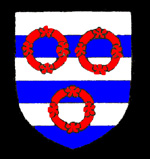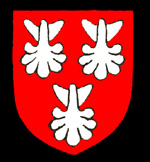Wyboston Manor
Volume III of The Victoria County History for Bedfordshire, published in 1912, gives a detailed history of manors in Wyboston as far as it was then known. Wyboston Manor had its genesis in one of the six holdings in the area detailed by Domesday Book in 1086. Surprisingly, it came not from the largest holding, Nigel de Albini's nine hides, three virgates, but the second largest, six hides, three virgates belonging to Eudo the Steward, alias Eudo, son of Hubert. The manor was attached to the Barony of Eaton [Socon] as overlord, though in the 15th and 16th century the overlordship seems to have reverted to the Crown.

The Greystock coat of arms
The earliest known tenants of the manor, dating to the early 13th century, are members of the FitzWilliam family, who later became Barons of Greystock. In 1317 an inquisition on Ralph FitzWilliam, Baron Greystock's manor in Wyboston found it worth £10/2/ 7¼ per annum. His grandson Ralph assumed the name de Greystock. By 1358 the manor was worth £18.The last Lord Greystock died in 1487 and was succeeded by his infant daughter Elizabeth, who later married Thomas, Lord Dacre of Gillesland, their son being William, Lord Dacre and Greystock.

The Dacre family coat of arms
His son Thomas left three daughters, all minors, at his death in 1566 and Wyboston Manor passed to Anne, who married Philip Howard, Duke of Norfolk. It seems as if Wyboston was alienated in the late 1650s and by the early 18th century was in the hands of the Whetham family. The last known Lord of the Manor of Wyboston was Arthur Whetham in 1796.
 The Howard family coat of arms
The Howard family coat of arms